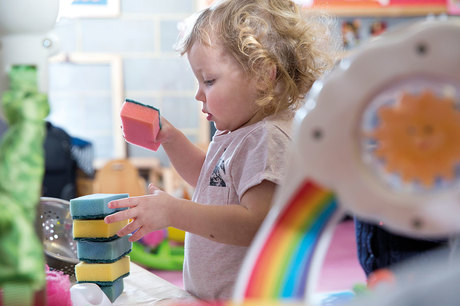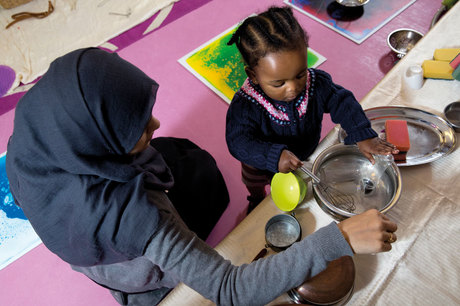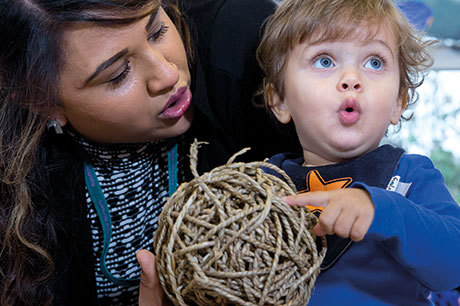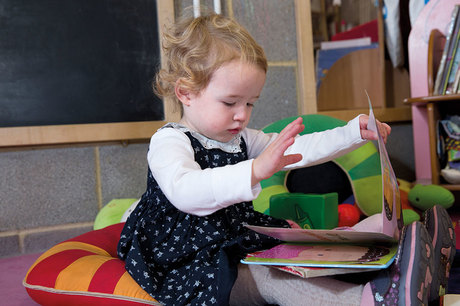
Eleven-month-old Josh is sitting on the carpet playing with a toy rabbit. His mum says, ‘Have you found your rabbit? He’s a lovely rabbit, isn’t he? Are you giving him a kiss? Ah! Is he dancing? He’s a lovely rabbit!’
This is the kind of conversation you hear people having with babies all the time. They spontaneously tune in to what has caught the child’s interest and they talk about it. This style of interaction is referred to as contingent talk – talk that is about (that is, contingent on) whatever has caught a baby’s attention. Recent research suggests that hearing contingent talk could boost early language development.
LANGUAGE LEARNING IN INFANCY
From the third trimester of pregnancy, babies start to tune in to the sounds of the language around them, picking up on its melodies and learning its rhythms. Gradually after birth, they start to associate meaning with these sounds and by six months there is emerging evidence that babies have learnt what some common words refer to. However, it’s not generally until around their first birthdays that babies start to produce words reliably, with some taking up to 24 months to do so – and late talkers taking longer still.
When word production starts isn’t important so much as where it eventually leads. Many months later, when children enter nursery and primary school, good language skills can help them to understand what is going on in the classroom environment. They can help them to communicate their wants and needs. And, of course, they help to build friendships with other children. For all of these reasons, it is important for us to get every child off to a good start.

LANGUAGE LEARNING AND SOCIO-ECONOMIC STATUS
Children’s chances of getting off to a good start at school are not equal. They depend in part on where a child is from. It has long been known that children from more socially disadvantaged areas tend to go to school with more limited language skills than children from more advantaged areas. Relative advantage is often measured according to a family’s Socio-Economic Status (SES), which takes into account parent education, family income and occupation.
The Office for National Statistics also provides an indicator of relative advantage with its Index of Multiple Deprivation. For each postcode in England, it combines measures of things like neighbourhood employment levels, provision of healthcare, income and housing, and then ranks the postcodes from least advantaged to most. Using tools like this, we can study how disadvantage is associated with child development.
Evidence from America and the UK indicates that from as early as 18 months, children’s language skills are associated with the socio-economic status of their family. This does not mean that social advantage determines language skills – many children buck the trend. But there is enough evidence of an association that we would want to find out whether there are ways of helping children be prepared for school and making sure that such help is effective for everyone.
To do this, we need to know how children’s experience of language learning differs from place to place and what things we might be able to do to promote language learning.

LANGUAGE IN THE HOME
One factor that explains why children from less advantaged areas are less likely to have strong language skills is what happens at home. The way that parents talk to their babies tends to differ according to culture and social advantage. In a study that we recently conducted, less advantaged parents tended to talk slightly less about what was in their child’s focus of attention.
There are lots of reasons why this might be – reasons that have to do with parents’ own language skills, their understanding of child development, their goals for their children and their feelings about being able to meet those goals. Simple things like whether or not a parent is likely to pick up a book with their baby can have quite an impact on the kind of language that baby hears.
When we followed children’s development until pre-school age, we found that the way in which parents had spoken to their child when s/he was a baby could predict later language outcomes. It certainly was not the only predictor or even the most important. In fact, the best indicator of later language was how well the baby was already communicating when they were just 11 months old. Nonetheless, there is evidence that talking to babies when they are young has an impact on their language development.

CONTINGENT TALK
One style of talking that seems to be particularly important in the nine- to 18-month period is what is referred to as contingent talk. As in the toy rabbit example earlier, this involves tuning into what a baby is interested in and then talking with them about it. So, when Josh hears the words like ‘rabbit’ and ‘kiss’ when giving his rabbit a kiss, there is a good chance he will learn something about how these words are used.
In contrast, if he heard someone talk about something he wasn’t already playing with, then he’d need to redirect his attention before he could begin to learn these words. There is good evidence that babies under the age of 18 months struggle to do this. There is also evidence that parents who engage in more contingent talk when their babies are young go on to have toddlers with larger vocabularies.
Is it possible to promote contingent talk and thereby help children learn to talk? Evidence regarding parenting interventions to promote child language is currently mixed, with some studies reporting positive findings and others reporting little effect when programmes are rolled out at a national level.
In a recent randomised controlled trial, we tested the effect of a contingent talk intervention. We showed first-time parents of 11-month-olds a short video about tuning in to their baby’s attention (noticing what they were looking at and playing with, noticing if they babbled or gestured) and talking to them about it. The parents were then asked to practise contingent talk for 15 minutes a day for a month.
After the month had passed, the parents who had taken part in this intervention were more likely to spontaneously engage in contingent talk compared with parents in a control group who had taken part in a matched intervention to do with dental health.
The contingent talk intervention also had a positive impact on the vocabulary development of babies from less socially advantaged families when they were 15 and 18 months, suggesting it helped language development. However, the effect of the intervention did not last when the babies turned 24 months, suggesting that if we want to make a difference we would need to have follow-up advice adapted to later developmental stages.
Nurseries could play an important role here as interventions in these settings have been shown to be effective for older children both when they are run on-site and when they work by engaging parents. Taken together, research to date suggests that it is possible to make a difference, but it would require very substantial funding to do so.

CONTINGENT TALK IN DAYCARE SETTINGS
There is ample evidence that quality of daycare affects children’s language outcomes. Nowhere does this make more sense than in baby rooms where staff need to divide their attention between more than one baby. The chances of any given child hearing language that is about what they are attending to are almost inevitably reduced.
We know from studies of twins that dividing attention between babies can be tricky to do and can result in slight language delays compared with children who can more easily attract one-to-one attention. It seems likely, then, that providing early years professionals with training in techniques such as contingent talk might help to improve outcomes from very early on. More research is needed to find out whether this would be effective.
SUMMARY
Contingent talk is a style of interaction where a caregiver notices what their baby is attending to and then talks to them about it. It can be particularly helpful during the nine- to 18-month period when babies would otherwise find it difficult to learn about what the words in their language mean.
There is evidence that children from more socially disadvantaged areas tend to hear slightly less contingent talk on a day-to-day basis. In one recent study, a parenting intervention helped to promote contingent talk across the board and this helped socially disadvantaged babies’ language in the short term. It is early days for research in this area but, taken together, current research confirms the commonsense view that nurseries could play a key role in helping children get off to a good start at school.
Dr Danielle Matthews is a reader in cognitive development and Michelle McGillion is a post-doctoral researcher in the Department of Psychology, University of Sheffield. Julian Pine is a Professor in the Department of Psychological Sciences at the University of Liverpool and co-director of the ESRC International Centre for Language and Communicative Development (LuCiD), www.lucid.ac.uk. (Our six-part series by LuCiD researchers is at: www.nurseryworld.co.uk/communication-language).
TUNING IN AND TALKING
A recent study found that providing parents with the following tips helped to promote contingent talk. You can usually tell that a baby is interested in something if:
- they are looking at it
- they are playing with it, holding it or moving it around
- sometimes, they may pointat an object or try to show or give it to you
- or, they may babble or shout or laugh about the object.
When you notice the baby doing one of these things, talk to them about what has captured their interest. It might help them learn to talk.
Find out more about infant language development at: http://beforefirstwords.upf.edu
REFERENCES
- Baldwin, D (1991). Infants' contribution to the achievement of joint reference. Child Development, 62, 875-890.
- Belsky, J, Vandell, DL, Burchinal, M, Clarke-Stewart, KA, McCartney, K, & Owen, MT (2007). Are there long-term effects of early child care? Child Development, 78(2), 681-701.
- Carpenter, M, Nagell, K, & Tomasello, M (1998). Social cognition, joint attention, and communicative competence from 9 to 15 months of age. Monographs of the Society for Research in Child Development, 63(4), i-vi, 1-143.
- Clegg, J, & Ginsborg, J (Eds). (2006). Language and social disadvantage: Theory into practice. John Wiley & Sons.
- Fernald, A, Marchman, VA, & Weisleder, A (2013). SES differences in language processing skill and vocabulary are evident at 18 months. Developmental Science, 16(2), 234-248.
- Fricke, S, Bowyer-Crane, C, Haley, AJ, Hulme, C, & Snowling, MJ (2013). Efficacy of language intervention in the early years. Journal of Child Psychology and Psychiatry, 54(3), 280-290.
- Hoff, E (2003). The Specificity of Environmental Influence: Socioeconomic Status Affects Early Vocabulary Development via Maternal Speech. Child Development, 74(5), 1368-1378.
- Landry, SH, Smith, KE, & Swank, PR (2006). Responsive parenting: establishing early foundations for social, communication, and independent problem-solving skills. Developmental Psychology, 42(4), 627.
- Law, J, Reilly, S, & Snow, PC (2013). Child speech, language and communication need re-examined in a public health context: a new direction for the speech and language therapy profession. International Journal of Language & Communication Disorders, 48(5), 486-496.
- McGillion, ML, Herbert, JS, Pine, JM, Keren-Portnoy, T, Vihman, MM, & Matthews, DE (2013). Supporting early vocabulary development: What sort of responsiveness matters. IEEE Transactions on Autonomous Mental Development, 5(3), 240-248. doi:10.1109/TAMD.2013.2275949
- McGillion, ML, Pine, JM, Herbert, JS, & Matthews, D (submitted) A Randomised Controlled Trial to Test the Effect of Promoting Caregiver Contingent Talk on Language Development in Infants from Diverse SES Backgrounds.
- Nutbrown, C Hannon, P & Morgan A. (2005) Early Literacy Work with Families: policy, practice and research. London: Sage.
- Smith, T, Noble, M, Noble, S, Wright, G, McLennan, D, & Plunkett, E (2015). The English Indices of Deprivation 2015. Department for Communities and Local Government.
- Thorpe, K, Rutter, M, & Greenwood, R (2003). Twins as a natural experiment to study the causes of mild language delay: II: Family interaction risk factors. Journal of Child Psychology and Psychiatry, 44(3), 342-355.
- Wake, M, Tobin, S, Girolametto, L, Ukoumunne, O C, Gold, L, Levickis, P, . . . Reilly, S (2011). Outcomes of population based language promotion for slow to talk toddlers at ages 2 and 3 years: Let’s Learn Language cluster randomised controlled trial. BMJ, 343, d4741.
- Ward, S (1999). An investigation into the effectiveness of an early intervention method for delayed language development in young children. International Journal of Language & Communication Disorders, 34(3), 243-264.
MASTERCLASS: TIME TO TALK
Find out more about early language development and how to support it at the Nursery World Show, where Dr Danielle Matthews will be leading our masterclass ‘Closing the Gap, Birth to Three’, on Saturday, 4 February.
According to the Education Endowment Foundation, effective support strategies for communication and language enable disadvantaged children to make up to six months’ additional progress over the course of a year.
Dr Matthews will consider the latest research findings on language development and elaborate on ‘contingent talk’.
Penny Tassoni will then look at essential experiences for promoting children’s communication skills, and key features of a language-rich enabling environment.
Alice Sharp will look at a child’s earliest steps towards literacy and essential strategies for support in the home.
For more information, visit www.nurseryworldshow.com
Download the PDF









